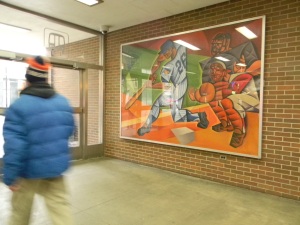Chicago troupes take the stage at Dance Chicago 2012’s latest run, giving the world a glimpse of the international caliber of the local dance scene.
Chicago is known for many things: pizza, skyscrapers, Da Bears… and if John Schmitz has his way, it will also be known for dance.
Schmitz is the longtime curator and artistic director of Dance Chicago, a nonprofit
movement focused on bringing Chicago choreography to the forefront of the international arts consciousness. So far, he’s been successful, with rave reviews flooding in from Time Out Chicago and the Chicago Tribune.
Choreographer-turned-director Schmitz focused on cultivating Chicago talent after growing frustrated with shows coming through that city that showcased foreign talent.
“We’re the only organization in Chicago that focuses on Chicago choreographers,” Schmitz said. “Hubbard Street spends no money on it, Joffrey spends no money on it, River North spends no money on it – they don’t want to spend no money on it.”
“These companies have dancers not from Chicago, choreographers that are not from Chicago. So they’re what I call corporate companies – they’re corporate funded, they’re based on a corporate model, they’re appealing to the higher income donors.”
Schmitz’s strategy? Take foundational support, mix it with local Chicago talent, and incubate the best choreographers for a force of Chicago dancers that rival those of internationally acclaimed stages.
At the same time, Schmitz wants to make dance an accessible art form for all. That’s why he created Dance Slam: think “So You Think You Can Dance,” the popular television show that has hosted many of Schmitz’s protégés, meets “America’s Got Talent.”
“Dance Slam is very participatory,” Jeff DeLong, marketing director at the Athaenaeum, said, pointing towards the voting nature of Dance Slam as the reason for its success.
Schmitz agrees. “Dance Slam was never intended to be a competition, but we wanted something that was interactive. It sort of developed into this.”
Another reason for its success? Schmitz has managed to democratize dance and make it something everyone can access.
“We’re the audiences that don’t have a lot of money, we’re the artists that don’t get paid, we’re the choreographers that are good but haven’t had our names branded yet in the dance world. I know this model works because we give birth to [great] people” – such as tap impresario Lane Alexander and modern dance choreographer Kate Jablonski.
The diversity of dance genres practiced in Chicago is Dance Chicago’s strength. “Right now, Chicago has one of the most vibrant tap communities in the world,” Schmitz said. “Urban dance is strong here, ethnic dance is strong here, Trinity is the best Irish dance company in the world – I mean, they’re all here.”
Schmitz hopes to not only provide affordable, high quality art to the average citizen but also promote dance as a truly universal art form that defines not only the Chicago arts scene but also the emerging world arts scene.
“Dance is visual music,” Schmitz said. “You can do things with dance that you can’t do with theatre, you can’t do with comedy improv. There ought to be more money invested in dance.
“Every culture has dance. It’s nonverbal. We could solve a lot of conflict in this world through dance.”






